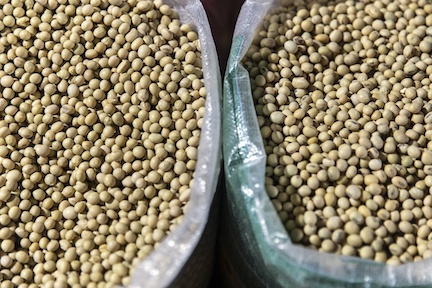China to further expand oilseed production to reduce imports
China will grow rapeseed on more land and stabilize soybean acreage this coming year, extending a policy drive to boost oilseed harvests and cut reliance on overseas supplies in the top consumer.
The country has sought to increase output of oilseeds such as soybeans and rapeseed, and cut the ratio of meal used in animal feed, as food security becomes an increasingly important priority post-Covid and trade tensions deteriorate with the US, a top supplier of farm products.
In the new year, China will “stabilize soybeans” and look to focus on boosting yields, with plans to expand planting of genetically modified soybean and corn varieties, agriculture ministry officials said at a media briefing Tuesday.
Production of soybeans, the most consumed oilseed in the country, rose significantly in the past few years, thanks to increasing acreage. But farmers have suffered as the beans struggle to find a market, while the larger acreage has cut planting of other main crops like corn.

China has reduced the soybean meal ratio in animal feed to 13%, down 1.5 percentage points from 2022, and equal to the consumption of about 9 million tons of soybeans, an official from the agriculture ministry said at the media briefing organized by the State Council.
Imports Near Record
Soybean shipments to China climbed 11% last year to 99.41 million tons, almost matching the all-time high in 2020, customs data showed this month. Any big jump in the local crop that finds its way into commercial crushing could significantly cut the country’s buying on the global market.
Apart from boosting yield and stabilizing acreage, the ministry will also focus on reducing losses from agricultural disasters.
Meteorological conditions for farming in China this year will be generally poor, and the challenges of fighting disasters and securing bumper harvests remain severe, said Pan Wenbo, head of the ministry’s plantation-management division.
The ministry will draw up contingency plans for disaster prevention in different regions and crops and establish regional centers to respond to catastrophes and secure grain production.
Similar Stories

November 2024 Freight Transportation Services Index
View ArticleViet Nam hosts 16th United Nations Conference on Trade and Development In October 2025
UN Trade and Development (UNCTAD) Secretary-General Rebeca Grynspan announced today that the sixteenth session of the United Nations Conference on Trade and Development (UNCTAD 16) will take place in Viet…
View Article
Alleima relaunches high-strength and corrosion-resistant steel for sustainable energy sectors
View ArticleUnited States and Norway issue innovative report creating greater transparency in critical mineral supply chains
Today, the U.S. Department of Commerce and the Norwegian Ministry of Trade, Industry, and Fisheries issued a thorough, innovative report presenting our shared understanding of non-market policies and practices (NMPPs)…
View ArticleDecember CNBC/NRF retail monitor results show strong growth boosted by final Thanksgiving weekend days
Retail sales jumped strongly in December, boosted in part by two busy holiday shopping days during Thanksgiving weekend falling in the final month of the year, according to the CNBC/NRF…
View ArticleNAW presents Dirk Van Dongen Lifetime Achievement Award to Bergman, CEO of Henry Schein, Inc.
At the 2025 NAW Executive Summit Gala on January 28 in Washington, D.C.
View ArticleGet the most up-to-date trending news!
SubscribeIndustry updates and weekly newsletter direct to your inbox!





